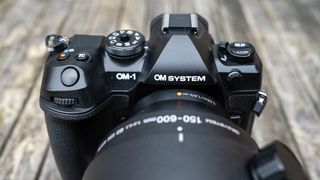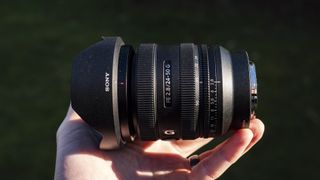The OM System OM-1 II is a fantastic camera with some incredible features and functionality, notably impressive image stabilization and the Live Graduated ND filter feature. These, on top of the excellent autofocus performance and the Live ND filter, make it a great option for wildlife and landscape photographers alike. Wwith only a handful of upgrades from the previous model, it’s arguably not worth the upgrade from the OM-1. But if you’re moving to OM System or upgrading from a lower-spec model, this is a camera you will undoubtedly love.
Pros
- +
Impressive 8.5 stops image stabilization
- +
Range of digital ND filters
- +
IP53 weather sealing
Cons
- –
Not a huge update over the OM-1
- –
Only a 20MP sensor
- –
4K video tops out at 60fps
Why you can trust TechRadar We spend hours testing every product or service we review, so you can be sure you’re buying the best. Find out more about how we test.
OM System OM-1 II: two-minute review
There’s long been a snobbery when it comes to camera formats going back to the days of film. But with digital photography, while this does remain to some extent, the camera landscape is completely different and smaller sensor Micro Four Thirds (MFT) cameras are often some of the most advanced cameras available.
The OM System OM-1 Mark II is one such camera, but it’s more of an incremental update over the original OM System OM-1 than a significant upgrade. However, the new model is still one of the most technologically advanced cameras currently available, offering features and functionality that could easily tempt photographers away from larger format APS-C and full-frame cameras, especially those looking for a lightweight camera system.
The OM-1 II offers many of the same features as the original, including the same 20MP back-illuminated sensor with its 1053-point AF system, 50fps when shooting with continuous autofocus, Live ND filters (software-based) alongside the IP53-rated weather-sealed body to name but a few. The two cameras also look remarkably similar, nearly identical, so what’s so special about the OM1-II?

The OM-1 II is undoubtedly a stunning camera that handles incredibly well and offers features and functionality that I wish my larger sensor cameras had, and I’ll cover many of these in more detail later. But this level of functionality doesn’t come cheap – the body-only price is $2,400 / £2,199 / AU$3,599.
This price puts it in the same bracket as many mid-range full-frame cameras, which can seem like a negative when you’re getting a much smaller sensor. However, you’re getting a typically smaller and lighter camera system, including the lenses, which most OM System fans favor. It’s an easier-to-carry and more compact system that’s capable of shooting any subject, excelling in landscape and wildlife photography.
OM System OM-1 II: design
With its rugged build quality offering IP53-rated splash and dust resistance, alongside being able to withstand freezing temperatures down to -14 degrees fahrenheit / -10 degrees celcius, this compact and lightweight camera is designed to withstand the rigors of outdoor photography.
The OM-1 II is slightly smaller than the average full-frame mirrorless camera, plus, it’s lighter at 1.32lbs / 599g including a battery and memory card. There are also two SD card slots for dual recording and redundancy.
Despite its slightly smaller size, the camera is comfortable to hold thanks to a well-contoured grip and an excellent thumb plate on the back. If you could say a camera fits your hand like a glove, it’s the OM-1 II.
There are plenty of direct controls for speedy access to key camera settings, and the menu system itself is well laid out and easy to navigate, which can be an easily overlooked benefit of any camera. Although the OM-1 II looks almost identical to its predecessor, the newly rubberized dials provide greatly improved grip and overall feel.

Shooting with the OM-1 II is an absolute pleasure, and the 5.76m-dot EVF that now has a blackout-free display when shooting at even the highest frame rates available provides a beautifully clear and bright image.
The LCD on the back is also impressive, but as is often the case, this is lower resolution than the EVF. The 3-inch vari-angle 1,620K dot touchscreen is convenient, clear and bright, but some of the on-screen icons are on the small side.
The only thing that I don’t like about the design of the camera is that the on/off switch is on the left side of the camera, rather than on the right where you hold the camera. Right positioning makes it much easier to switch cameras on and off when you pick them up by the grip.
But although in my opinion, this would be much better, the switch positioning certainly isn’t a dealbreaker and is likely to be something you’d get used to if you’re switching from a different camera system.
OM System OM-1 II: performance

This is a camera that owes much of its prowess to computational power which includes AI algorithms. I’m not talking about generative AI for image creation, this is AI that aids the functionality and performance of the camera.
One area where this is put to work is with the improved AI subject recognition that can be set to detect six different subjects as well as being switched off. This subject detection worked extremely well during testing, and the bird setting was fantastic for shooting birdlife, often detecting their eye which is both useful and impressive.
One of the headline new features is Live Graduated ND, which is a digital grad available in 1-stop, 2-stop and 3-stop strengths and can be set to soft, medium or hard graduations (see examples, below). As a landscape photographer who uses square filters, I found these digital equivalents offered harder graduations than my glass filters, but they’re still extremely effective.
There’s unfortunately no reverse grad option for shooting sunrises and sunsets, although the grad can be rotated to most angles. You also have to shoot in manual mode to avoid the foreground exposure from brightening, which is a little odd since you’d expect the algorithm to account for this. Still, it’s undoubtedly an impressive feature.

No Live GND filter to 3EV progression alongside a back of camera to show the on-screen Live GND.
The new Live Graduated ND sits alongside Live ND Shooting, which has been extended to ND128 / 7-stops with the OM-1 II to provide long exposure capabilities in-camera, as well as wide aperture shooting in bright conditions.
The main downside to these two digital filters is that they can’t be used in conjunction, so landscape photographers will need to continue using traditional optical filters in situations where they need to use both ND filters and ND grads. Hopefully, dual shooting could be implemented in a firmware update, and if this is possible it would be phenomenal.
With 8.5 stops of 5-axis in-body image stabilization (IBIS), the OM1-II beats its predecessor here by 1.5 stops, thanks again to software rather than a hardware upgrade. Sync IS also allows the IBIS to work in conjunction with the optical stabilization available in lenses, so when using the OM System 150-600mm F5.0-6.3 IS, for example, I was able to shoot at 600mm (1200mm equivalent) handheld at shutter speeds as low as 1/200 sec, which is nothing short of mind-blowing.
Last but not least, with many of the same fundamentals as the OM System OM-1, image quality is comparable and is overall excellent. ISO handling is best up to ISO 1600 and you could confidently shoot up to ISO 6400 when necessary, although like any camera it’s always best to shoot at the lowest ISO setting possible for the subject and situation you’re shooting.
Then there’s the advanced AWB algorithm that’s claimed to ensure precise color reproduction, which does indeed do a great job and was either perfect or just a little off during testing. Video capture has also seen some improvements, but 4K capture still tops out at 60fps where 120fps would be preferable for slow-motion capture.
Should I buy the OM System OM-1 II?

Buy it if…
You want to ditch some optical filters
With digital ND and ND grad filters, the OM-1 II removes the need to use traditional optical filters, although the two types of digital filters can’t be used at the same time so you may still need to carry ND grads or ND filters.
You shoot wildlife
With excellent AF performance, AI-assisted subject detection, fast shooting speeds, weather resistance and impressive image stabilization, this camera is (almost) perfect for wildlife photography.
